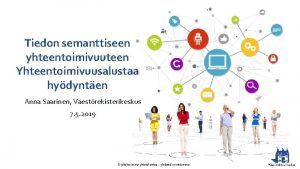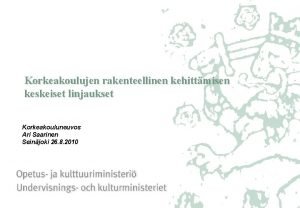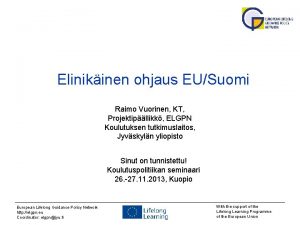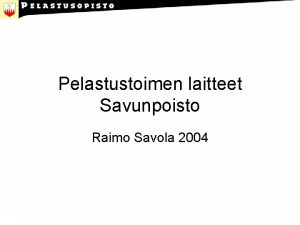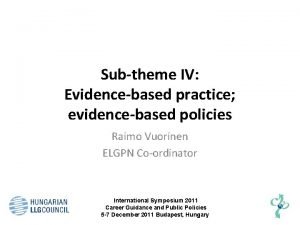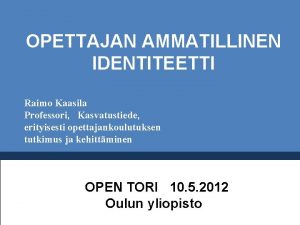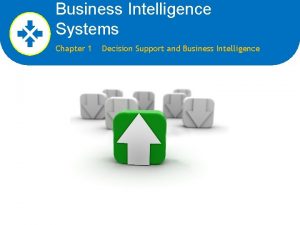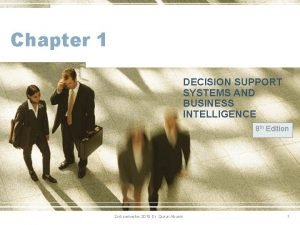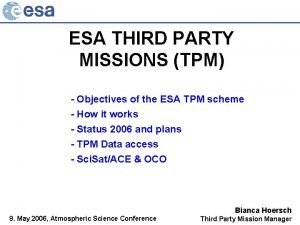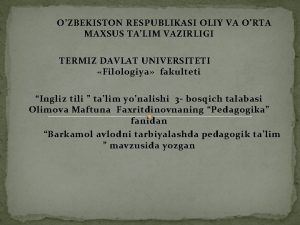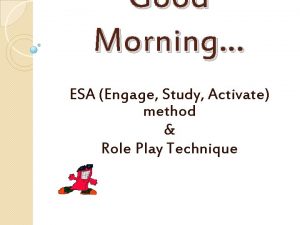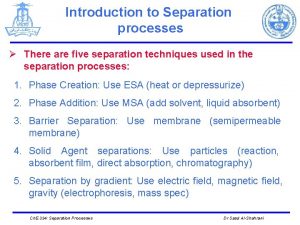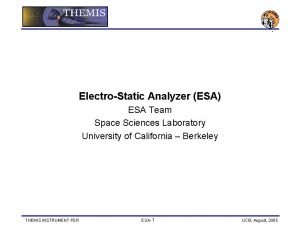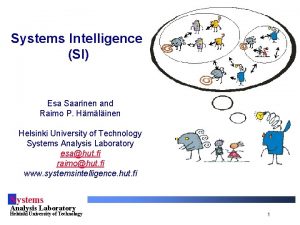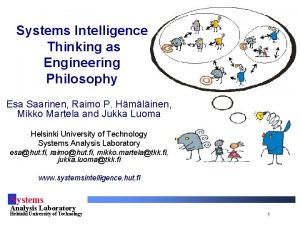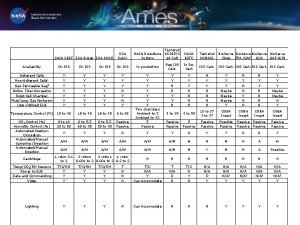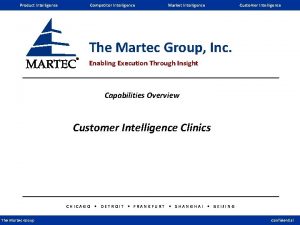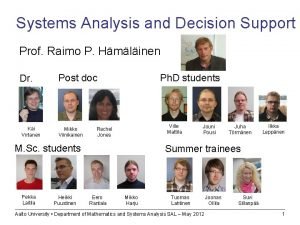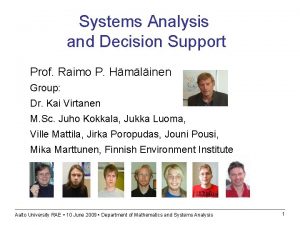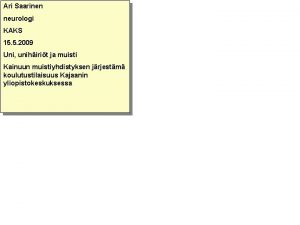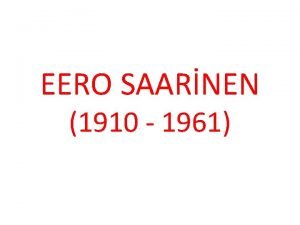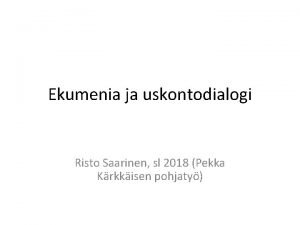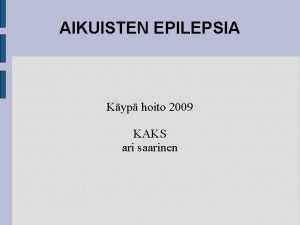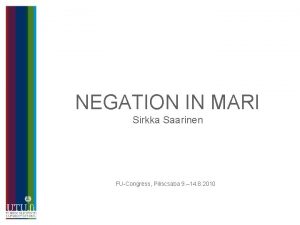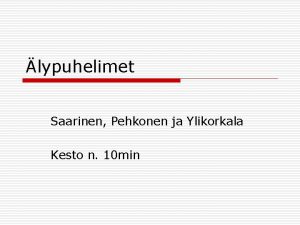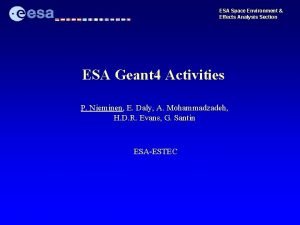Systems Intelligence SI Esa Saarinen and Raimo P




































- Slides: 36

Systems Intelligence (SI) Esa Saarinen and Raimo P. Hämäläinen Helsinki University of Technology Systems Analysis Laboratory esa@hut. fi raimo@hut. fi www. systemsintelligence. hut. fi S ystems Analysis Laboratory Helsinki University of Technology 1

Topics for Discussion Could it be that. . . • • • SI is a hidden/ignored innate capacity in all of us SI is an iconic concept stimulating thinking and action Becomes a personal learning challenge Is an essential prerequisite for future leadership An asset in personal and organizational life Can be a wisdom when negotiating and resolving complex global conflicts and environmental problems • Can be introduced and trained in schools • SI manifests itself in many ways in our everyday life S ystems Analysis Laboratory Helsinki University of Technology 2

Definition of Systems Intelligence • Intelligent behaviour in the context of complex systems involving interaction, dynamics and feedback • A subject acting with Systems Intelligence engages successfully and productively with the holistic feedback mechanisms of her environment • She perceives herself as part of a whole, the influence of the whole upon herself as well as her own influence upon the whole • By observing her own interdependence in the feedback intensive environment, she is able to act intelligently S ystems Analysis Laboratory Helsinki University of Technology 3

Systems Intelligence • Combines human sensitivities with engineering thinking with the idea of making things work • Systems Intelligence is a mirror that helps to identify productive forms of action one already follows intuitively • Our conviction is that Systems Intelligence is a key form of human intelligence • A fundamental element in the adaptive human toolbox • It is a competence that can be improved by learning S ystems Analysis Laboratory Helsinki University of Technology 4

The Fifth Discipline (Senge 1990) Cornerstones of learning organizations: • • • Personal Mastery Mental Models Shared Vision Team Learning Systems Thinking Systems Intelligence is the fundamental link between Personal Mastery and Systems Thinking. S ystems Analysis Laboratory Helsinki University of Technology 5

Multiple Intelligences (Howard Gardner 1983) • • Linguistic Intelligence Musical Intelligence Logical-Mathematical Intelligence Spatial Intelligence Bodily-Kinesthetic Intelligence The Personal Intelligences – intra / inter Gardner: These do not yet explain higher-level cognitive capacities e. g. common sense, metaphorical capacity or wisdom S ystems Analysis Laboratory Helsinki University of Technology 6

SI and Multiple Intelligences • SI points beyond the forms of intelligence of Gardner (Multiple Intelligences), Goleman and others (Emotional Intelligence, Social Intelligence) • Links intelligence with the concept of system • Systems Intelligence is another important higher level human cognitive capacity • Inspiration from the work of Peter Senge (1990) • Systems Intelligence is a survival asset we have as a species S ystems Analysis Laboratory Helsinki University of Technology 7

Systems Intelligence links with… • Systems Thinking (Churchman 1968, Senge 1990, Oshry 1996, Checkland 1999, Flood 1999, ) • Organizational theories and learning, Action research, Philosophical Practice and Dialogue (Argylis&Schön , Schein , Bohm 1980, Isaacs 1999, ) • Socratic tradition in philosophy which emphasises conceptual thinking for the purposes of the good life (Hadot 1987, Long 2002) • Therapeutic thinking, positive psychology and situation analysis (Bateson 2000, Goffman 1974, Seligman 2002) • Theories of Decision Making and Problem Solving (Simon 1956, Keeney 1992, Kahneman, Tversky S ystems 2000) Analysis Laboratory Helsinki University of Technology 8

Systems Thinking - the common understanding • • Observes interdependencies and wholes Views matters from different perspectives Especially through the eyes of others Becomes Systems Intelligence when a person takes active personal responsibility for her actions within the system S ystems Analysis Laboratory Helsinki University of Technology 9

Systems Thinking is only the first step • Emphasizes the importance of wholes and perspectives as it conceptualises and models systems of interaction and feedback from outside • Can become a trap when one only sees systems from outside and does not recognize herself being an active part of them S ystems Analysis Laboratory Helsinki University of Technology 10

Systems Intelligence Basic ideas – Structures • Structure produces behaviour • Beliefs regarding structures produce behaviour • Beliefs regarding the beliefs others have regarding structures, produce behaviour • Structures of co-operation are fundamentally based on the assumptions and meta-assumptions people make of others involved in that system of cooperation • Structures determine the patterns and dynamics of interaction S ystems Analysis Laboratory Helsinki University of Technology 11

Systems can take over • People can get caught in systems (organizations) that serve nobody’s interest • There does not need to be an external reason for the particulars of a system • Yet people in the system can feel helpless regarding their possibilities of changing the system • In most systems, each subject separately reacts to the system without seeing the cumulative overall effect of the reactive behaviours on the others S ystems Analysis Laboratory Helsinki University of Technology 12

From Systems Thinking. . . • The environment and one’s place in it are perceived in terms of interconnectivity and interdependence • The systems perspective wants to see the world as composed of systems, to examine these entities as wholes But also: • “Part” and “Whole” are relative abstractions • They are mental constructs, which are relative to the perspective adopted i. e. subject to redefinition • Boundaries of a system can always be redrawn S ystems Analysis Laboratory Helsinki University of Technology 13

. . . to Systems Intelligence • Unlike Systems Thinking (in its narrow meaning), Systems Intelligence is primarily outcome-oriented and not a descriptive effort only • Unlike Systems Thinking, Systems Intelligence involves driving change and actively embracing change • Becomes a challenge for personal learning • The theoretical understanding of Systems Thinking does not need to increase Systems Intelligence S ystems Analysis Laboratory Helsinki University of Technology 14

Thinking about Thinking • Systems Intelligence begins when a person starts to re-think her thinking regarding her environment and the feedback structures and other systems structures of that environment • Identifying one’s favoured framing patterns, challenging them and adjusting them accordingly • A Systems Intelligent person will acknowledge the limitations of her thinking and mental models particularly through challenging her own thinking S ystems Analysis Laboratory Helsinki University of Technology 15

Seeing oneself in the system • The impact of one’s behaviours and interaction patterns upon the behaviours of others • The impact of other agents’ feedback on my behaviour • The impact of the current system on all of us is in the long run • The modes of conformity I have already adopted as a result of established practices • The modes of conformity the others have already adopted as a result of established practices • The desired ideal state I would like to reach with the others S ystems Analysis Laboratory Helsinki University of Technology 16

SI Connects Engineering Thinking with Emotions • From reactive behaviour into the intelligent management of situations, feelings and the whole • Human emotions are essential – they cannot be ignored – their systemic effects need to be taken into account intelligently • A systems engineering perspective to the systemic impacts of emotions S ystems Analysis Laboratory Helsinki University of Technology 17

Simple acts of Systems Intelligence in Everyday Life • • Appreciation No judgements Interest Humor Listening Thanking Encouragement Friendliness S ystems Analysis Laboratory Helsinki University of Technology 18

Managing the invisible • In most human systems and organizations the true system often includes hidden subsystems such as fear and trust generation or belief formation • It is very easy to forget to use behavioural input variables controlling such invisible parts • To understand the system, it can be more important to know what is not produced than what the standard output is • A Systems Intelligent approach acknowledges and aims to identify and understand both the visible and invisible part of the system and find inputs to impact their behaviour in a positive way S ystems Analysis Laboratory Helsinki University of Technology 19

Optimism for change • Systems Intelligence focuses on changes as leveraged by the human mental world and the systemic nature of life around us • Systems Intelligence acknowledges that beliefs influence actions and actions influence beliefs. • There might be a systematic flaw in the way a group of agents perceives the way others think and what they truly want • A relatively small change in my behaviour might trigger a chain of changes in the actual behaviours in each of us S ystems Analysis Laboratory Helsinki University of Technology 20

Systems Intelligence Archetypes • “Fixes that Fire” – triggering systemic change, resonance, bifurcation/chaos with positive long term impacts • “Sharing Away the Burden” – we have a dream, open source philosophy • “Miracle of the Commons” – evolution of cooperation through reciprocity S ystems Analysis Laboratory Helsinki University of Technology 21

Systems Theory and Systems Intelligence • A system is defined by identifying the system inputs i. e. control, intervention, decision or stimulus variables and system output variables i. e. the observed responses or reactions • The state of a system consists of the variables representing the elements in the system which determine its future behaviour • Systems can have many different state representations S ystems Analysis Laboratory Helsinki University of Technology 22

Complexity Well known parts – unknown interactions control / intervention output / observation • The interdependence of subsystems is unknown • Sometimes a minor intervention can trigger unexpected, chaotic or bifurcating responses in the system • The most essential part of the system may be one that was never intentionally built into it S ystems Analysis Laboratory Helsinki University of Technology 23

Observability The observability of subsystems control/ intervention output/ observation/ measurement • A system is observable if one can derive the values of all the states by a sufficiently long observation of the outputs • Without a sufficient set of observation (measurement) variables one can remain unaware of important active subsystems • You cannot manage systems which you do not see S ystems Analysis Laboratory Helsinki University of Technology 24

Controllability The controllability of subsystems control/ intervention output/ observation • A system is controllable if it can be driven to any state value by sufficiently rich controls • In addition to the seemingly controllable visible system there can be an uncontrollable subsystem – human or technical • You must have a sufficient set of inputs to cause an impact on all the states S ystems Analysis Laboratory Helsinki University of Technology 25

Systems Intelligence control/ intervention Systems Intelligent intervention output/ observation Seeing the previously invisible parts • SI looks for ways to observe and address the invisible subsystems and interactions of emotions and beliefs • Without the management of the whole the structure starts to produce uncontrollable behaviour – we have systems dictatorship S ystems Analysis Laboratory Helsinki University of Technology 26

Uncontrollability – System Dictatorship • The structure and limited input and observation variables can create a situation of uncontrollability – system dictatorship • Even if a system mainly consists of human agents the overall behaviour can be determined by the nonhuman elements and dynamic structures such as time delays and sequential communication patters (e. g. Beer Game, Senge 1990) • Systems Intelligence is aware of structures: even if all the agents try to do their best the resulting system response can be bad due to the structure S ystems Analysis Laboratory Helsinki University of Technology 27

Systems Intelligent Organization • Empowers people to share their mental system models of the organization and to consider the effects of their own actions on the whole • Fosters and sustains inquiry mode and reduces advocacy • Keeps fear factors down • Helps people to be responsive to flourishing initiatives • Builds trust in the good will of others • Sees that its production capacity is not restricted to the measurable variables but is extended to the world of emotions and well being • Elevates innovativeness by an environment where emotional variables do not limit performance S ystems Analysis Laboratory Helsinki University of Technology 28

5 Levels of SI for self-evaluation and measurement of SI 1. Seeing oneself in the System – Ability to see oneself and ones roles and behaviour in the system. Also through the eyes of other people and with different framings of the system. Systems thinking awareness. 2. Thinking about Systems Intelligence – Ability to envision and identify productive ways of behaviour for oneself in the system and understanding systemic possibilities. 3. Managing Systems Intelligence – Ability to personally excercise productive ways of behaviour in the system. 4. Sustaining Systems Intelligence – Ability to continue and foster systems intelligent behaviour in the long run. 5. Leadership with Systems Intelligence – Ability to initiate and create systems intelligent organizations S ystems Analysis Laboratory Helsinki University of Technology 29

Systems Intelligent Leader Strives to learn and reach Level 5 • Sees himself in the system with a mission to develop a Systems Intelligent Organization • Is aware of the human perspective • Operates within the visible system and manages the emotional system simultaneously • Is not held captive by the mechanistic perspective • Identifies and eliminates structural systems dictatorships Systems Intelligence has become an iconic personal growth challenge and a success asset S ystems Analysis Laboratory Helsinki University of Technology 30

Ecological Systems Intelligence • Evolutionary processes exhibit a spontaneous emergence of co-operation generating superior overall behaviour for all the actors (Axelrod 1984, Gintis et al. 2003) • Human decision making does not follow the axioms of rationality assumed in economic theory. • Bounded rationality: choice behaviour strongly reflects the systemic decision environment • We can escape the Prisoner’s Dilemma: a deviation from local status quo is not possible by self-interested rationality • Can be interpreted as a manifestation of ecological Systems Intelligence? S ystems Analysis Laboratory Helsinki University of Technology 31

Games People Play In experimental games : People do not take everything for themselves. They choose co-operative strategies reflecting Systems Intelligence. S ystems Analysis Laboratory Helsinki University of Technology 32

About SI Esa Saarinen and Raimo P. Hämäläinen: Systems Intelligence: Connecting Engineering Thinking with Human Sensitivity in: Systems Intelligence – Discovering a Hidden Competence in Human Action and Organizational Life, Raimo P. Hämäläinen and Esa Saarinen (Eds. ), Helsinki University of Technology, Systems Analysis Laboratory Research Reports A 88, October 2004 Downloadable at: www. systemsintelligence. hut. fi Systems Intelligence Research Group www. systemsintelligence. hut. fi/ Downloadable articles on SI: www. systemsintelligence. tkk. fi/SI 2004. html Saarinen Esa, www. sal. hut. fi/Personnel/Homepages/Esa. S. html www. esasaarinen. com/? kieli=en&etusivu Hämäläinen Raimo P. , www. raimo. hut. fi S ystems Analysis Laboratory Helsinki University of Technology 33

References Axelrod Robert. 1984. The Evolution of Co-operation, London, Peguin Books Bateson Gregory. 2000. Steps to an Ecology of Mind (Reprinted edition, original published in 1972) The University of Chicago Press Bohm David. 1996. On Dialogue. London, Routledge Checkland Peter. 1999. Systems Thinking, Systems Practice. Chichester, John Wiley Churchman C. West. 1968. The Systems Approach. New York, Delta De Botton Alain. 2000. The Consolations of Philosophy, London, Penguin Books Flood Robert L. 1999. Rethinking the Fifth Discipline: Learning Within the Unknowable, Routledge Gardner Howard. 1983. Frames of Mind: Theory of Multiple Intelligences, Tenth anniversary edition. New York, Basic Books. Gigerenzer Gerd and Selten Reinhard (editors). 2001. Bounded Rationality – The Adaptive Toolbox, Cambridge, The MIT Press S ystems Analysis Laboratory Helsinki University of Technology 34

References Gintis Herbert, Bowles Samuel, Boyd Robert and Fehr Ernst. 2003. Explaining Altruistic Behavior in Humans, Evolution and Human Behavior, Vol. 24, pp. 153 -172. Goffman Erving. 1986 (1974). Frame Analysis, Harper & Row Goleman Daniel. 1995. Emotional Intelligence, New York, Bantam Books Hadot Pierre. 2002 (French original 1995). What is Ancient Philosophy? Harvard University Press Haley Jay. 1986. Uncommon Therapy, The Psychiatric Techniques of Milton H Erickson, M. D. W. W. Norton & Company Ltd Hämäläinen Raimo P. and Saarinen Esa (Eds. ). 2004 b. Systems Intelligence - Discovering a Hidden Competence in Human Action and Organizational Life, Helsinki University of Technology, Systems Analysis Laboratory Research Reports, A 88, October 2004 Isaacs William. 1999. Dialogue and the Art of Thinking Together, New York, Doubleday Kahneman Daniel and Tversky Amos (editors) 2000. Choices, Values and Frames, Cambridge University Press S ystems Analysis Laboratory Helsinki University of Technology 35

References Keeney Ralph L. 1992. Value-Focused Thinking: A Path to Creative Decisionmaking, Cambridge, Harvard University Press Long A. A. 2002. A Stoic and Socratic Guide to Life, Oxford University Press Oshry, Barry. Seeing Systems: Unlocking the Mysteries of Organizational Life. San Francisco: Berrett-Koehler Publishers, 1996 Seligman Martin E. P. 2002. Authentic Happiness: Using the New Positive Psychology to Realize Your Potential for Lasting Fulfillment, New York, Free Press Senge Peter. 1990. The Fifth Discipline: The Art and Practice of the Learning Organization, New York, Doubleday Currency Senge Peter, Kleiner Art, Roberts Charlotte, Ross Richard B. and Smith Bryan J. 1994. The Fifth Discipline Fieldbook: Strategies and Tools for Building a Learning Organization, New York, Doubleday Currency Simon Herbert A. 1956. Models of a Man: Social and Rational, New York, Wiley Simon Herbert A. 1997. Models of Bounded Rationality, Volume 3, Empirically Grounded Economic Reason, Cambridge, The MIT Press. S ystems Analysis Laboratory Helsinki University of Technology 36
 Esa multimedia.esa.int./multimedia/virtual-tour-iss
Esa multimedia.esa.int./multimedia/virtual-tour-iss Anna saarinen
Anna saarinen Valtteri rauhala
Valtteri rauhala Ari saarinen
Ari saarinen Raimo uus
Raimo uus Raimo vuorinen
Raimo vuorinen Lämpösulake toiminta
Lämpösulake toiminta Raimo vuorinen
Raimo vuorinen Raimo kaasila
Raimo kaasila Decision support and business intelligence systems
Decision support and business intelligence systems Pxdes
Pxdes Decision support and business intelligence systems
Decision support and business intelligence systems Relationship systems intelligence
Relationship systems intelligence Esa tpm
Esa tpm Decision support systems and intelligent systems
Decision support systems and intelligent systems Perpus esa unggul
Perpus esa unggul Talimni tarbiyadan tarbiyani esa
Talimni tarbiyadan tarbiyani esa La significación el puesto del hombre en el cosmos scheler
La significación el puesto del hombre en el cosmos scheler Mario benedetti esa boca
Mario benedetti esa boca No corras para qué tanta prisa corre apenas dentro de ti
No corras para qué tanta prisa corre apenas dentro de ti Esa method
Esa method Cdf esa
Cdf esa Carla signorini
Carla signorini Takwa kepada tuhan yang maha esa
Takwa kepada tuhan yang maha esa American express esa
American express esa Zrak je zmes plinov
Zrak je zmes plinov Emma lackey
Emma lackey Sdge care discount
Sdge care discount Bap esa unggul
Bap esa unggul Pierre ferruit esa
Pierre ferruit esa Talimni tarbiyadan tarbiyani esa
Talimni tarbiyadan tarbiyani esa Separation procedures
Separation procedures El avión llegó ____.
El avión llegó ____. Myelooma parantuminen
Myelooma parantuminen Esa sso
Esa sso Esa
Esa Que es determinante demostrativo
Que es determinante demostrativo

